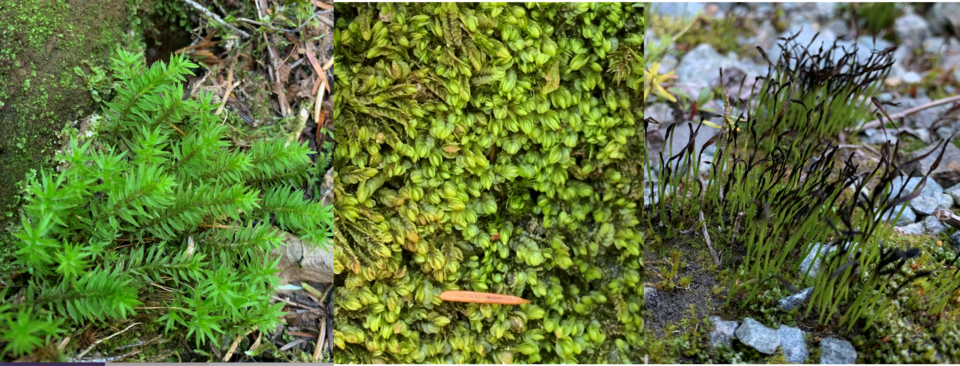Pretty much anywhere you may find yourself outdoors in Whistler, you can scan your surroundings and discern patches of something small, green, and alive. In the forest, the logs and trees you encounter are often adorned with these organisms, and the soil surrounding you is likely blanketed by them. In urban or open areas, surveying rock and disturbed soil will yield an assortment of small cushions and turfs, and if you find yourself next to a cliff face or in an area with water, these little green organisms are unavoidable. To the average person, these tiny but omnipresent characters likely share the single name of “moss.” How much of an understatement is that, really?
Mosses belong to a group of plants recognized by botanists as bryophytes, and in Whistler, more than 400 species are known so far! Apart from the immense diversity of mosses themselves, there are two other large lineages of plants in this same non-vascular grouping: liverworts and hornworts. Although not as well known or abundant as mosses, liverworts may be recognizable to many due to the landscaping- loving Marchantia polymorpha. Liverworts like these can take on distinctive forms, appearing like small, green straps or fish scales on the earth. While not uncommon sights, species with these forms do not represent a large portion of the total liverwort species in Whistler, rather, much of the diversity lies with their leafy cousins.
Superficially, leafy liverworts may seem quite similar to mosses if there’s no sporophyte, however, in taking a closer look (perhaps aided by a hand-lens), their alluring forms come into focus and certain patterns become evident. Liverwort leaves are often arranged in three rows: one on either side of the shoot, and one reduced on the undersurface. The leaves themselves can be very rounded to variously lobed, but rarely end in one elongated and sharp tip, and never have a discernible thick nerve in the middle. These patterns will prove helpful in initial investigations, but with a small bit of experience and time, a certain “vibe” will prove fairly recognizable. Among leafy liverworts, there is an enormous amount of diversity. They can be nearly threadlike (Cephalozia, Blepharostoma), deeply coloured (Marsupella, Scapania, Nardia), coral-like (Gymnomitrion, Anthelia), densely leafy (Schistochilopsis, Barbilophozia), or with small, shingling leaves (Frullania, Ptilidium, Porella) to name a few characters. Fortunately, out of all the liverwort species recognized in B.C., about half can be found without leaving Whistler!
Over the years of Whistler BioBlitzes, naturalists have spent time exploring and documenting these enigmatic little plants, finding more than 300 species of moss, 100 species of liverwort, and one species of hornwort. I was fortunate to join this year’s BioBlitz, and was very pleased to spot the elusive hornwort. These bryophytes may appear similar to a liverwort, however are readily identifiable by the often present cylindrical sporophytes, or “horns” projecting straight upwards. These structures can develop so densely that they could appear like a strange grass, but are in truth highly unique in the plant kingdom. Although I was only exploring for a few days, the diversity I saw spanned millions of years, and all I had to do was bend down for a closer look. Longer than we can comprehend, these little guys have been stabilizing the soil for other life, maintaining water levels in their ecosystem, providing rich habitat for invertebrates and microorganisms, and offering seeds with the perfect substrates for germination.
Their world is small, but if we take the time to bring ourselves into it, bryophytes will offer us an array of beautiful forms and captivating questions.
Naturespeak is prepared by the Whistler Naturalists. To learn more about Whistler’s natural world, visit their website.




